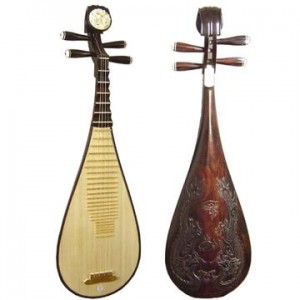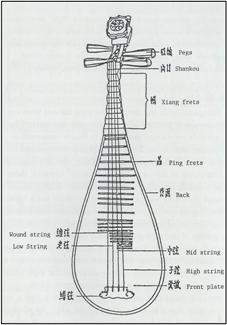Chinese Traditional Instruments: PíPá (琵琶) Posted by Stephen on Sep 27, 2011 in Uncategorized
 The pípá (琵琶) is a four-stringed, plucked Chinese musical instrument often referred to as the “chinese lute”. Similar to western guitars and mandolins, the pipa has a pear-shaped wooden body with a varying number of frets ranging from 12–30, depending upon the style and sound desired. Unlike the erhu, which is played with a bow (like a violin), the pipa is plucked either with fingers or with picks and is capable of producing a diverse set of tones, octaves and chords, that few other Chinese traditional instruments can.
The pípá (琵琶) is a four-stringed, plucked Chinese musical instrument often referred to as the “chinese lute”. Similar to western guitars and mandolins, the pipa has a pear-shaped wooden body with a varying number of frets ranging from 12–30, depending upon the style and sound desired. Unlike the erhu, which is played with a bow (like a violin), the pipa is plucked either with fingers or with picks and is capable of producing a diverse set of tones, octaves and chords, that few other Chinese traditional instruments can.
The pipa is one of the most popular Chinese instruments and has been played for nearly two thousand years in China. Its portability and simple design have made it a favorite across all classes and societies within China. As a result, the pipa is still widely played within the mainland, both in contemporary and classical contexts. This versatile little lute can produce some really complex and unique sounds.
Sound and Construction:
The word 琵琶 is comprised of the two different Chinese characters, “pí” (琵) and “pá” (琶) that represent the two most common ways of playing this instrument. “Pí” means to push the fingers of the right hand from right to left, much in the way a guitarist “finger picks”, allowing the musician to use multiple fingers to strike multiple notes. “Pá” conversely, means to pull the thumb of the right hand from left to right, in a sweeping, strumming motion in the opposite direction. Listen to this solo and you’ll hear the different “琵” and “琶” playing styles:
The strings were originally played using a large plectrum or “pick” in the Tang Dynasty, but were gradually replaced by the fingernails of the right hand. Pipa strings were originally made of softer twisted silk strings, but have recently been traded in for more durable nylon-wound steel strings. As a result, modern day pipa players use actual finger picks (similar to in a banjo) that essentially mimic longer and stronger finger nails. These fake nails are usually constructed of plastic or tortoise-shell fragments that are affixed to the fingertips with elastics, glue or tape.
The body of the pipa is hollow and tear shaped, often lacquered and engraved. The fretboard is raised up to join a crooked neck, with raised fret boards and wooden tuning keys. Fret numbers on the pipa range from 12 to 30, with more traditional pipas claiming fewer frets (and notes) prior to the introduction of the 12 note scale. In fact, the famous 21st pipa artist, Cheng Yu (a Chinese born, London musician), plays a five-stringed pipa, a style that has not existed for hundreds of years.
 During the Tang era, the pipa had become quite popular in the imperial court and could be heard serenading the royal families throughout the day. It had a crooked neck, 4 or 5 silk strings, and 5 or 6 frets, and was played with a plectrum in a horizontal position. As the ages went by, the crooked neck was replaced by a straight one and fret numbers increased. In the 1920s and 1930s, the number of frets was increased to 24, based on the 12 tone equal temperament scale, with all the intervals being semitones. Since then the number of frets has been extended to 29 or 30.
During the Tang era, the pipa had become quite popular in the imperial court and could be heard serenading the royal families throughout the day. It had a crooked neck, 4 or 5 silk strings, and 5 or 6 frets, and was played with a plectrum in a horizontal position. As the ages went by, the crooked neck was replaced by a straight one and fret numbers increased. In the 1920s and 1930s, the number of frets was increased to 24, based on the 12 tone equal temperament scale, with all the intervals being semitones. Since then the number of frets has been extended to 29 or 30.
While pipas are synonymous with traditional Chinese music, they are still widely played today, and are used across multiple genres in the mainland and abroad. They are favorites among Chinese composers as you’ll frequently here a pipa ringing in the background of a movie or TV show soundtrack.
In fact, hey even have electric pipas! Talk about modernization. Check out this Wu Man track called “Hangzhou Blues”:
http://www.youtube.com/watch?v=zI7yz_3IBRA
Raise your lighters or 火机 in the air! And then there is this west-meets-east, 2001 Incubus song: “Aqueous Transmission”, which features a pipa borrowed from the legendary Steve Vai:
http://www.youtube.com/watch?v=8s8YK4R5qa0
Now if only Jimi Hendrix had got his hands on one of these. Just imagine…
Follow Steve on twitter: @seeitbelieveit

Build vocabulary, practice pronunciation, and more with Transparent Language Online. Available anytime, anywhere, on any device.
About the Author: Stephen
Writer and blogger for all things China related. Follow me on twitter: @seeitbelieveit -- My Background: Fluent Mandarin speaker with 3+ years working, living, studying and teaching throughout the mainland. Student of Kung Fu and avid photographer and documentarian.




Comments:
Steven C. Poling Jr.:
Most people are lazy and say pi2pa.